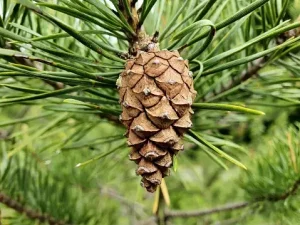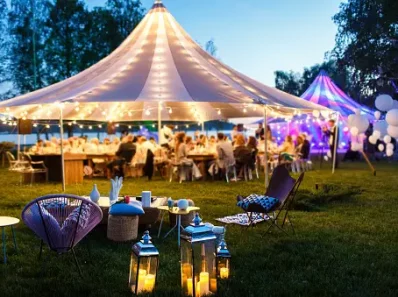
How to forage your festive decorations
With the Christmas period fast approaching, it’s time for us to start thinking about how we can create a fun and festive atmosphere in our homes. There are several ways to do this, including by cooking up delicious seasonal dishes and listening to our favourite Christmas playlist on repeat, but one of the best ways to do this by far is by decorating our house from head to toe in festive décor.
While Christmas decoration is great for getting us in the festive mood, it’s not always good for the planet, as much of it is made up of single-use plastic. So why not consider making some of your own decorations from natural materials you’ve foraged? Not only is this a more sustainable option, but it will save you money at an already expensive time of year too.
To help you forage your festive decorations this year, Burleigh is here to share the best natural materials to look out for and explain what we can make with them too.
The best seasonal materials and where to find them
One of the best things about foraging to create your own festive decorations is that there are so many great natural materials available this time of year. To give you some inspiration, here are just a few of the things you can use in your sustainable Christmas decorations:
· Evergreen foliage, such as ivy, holly, and mistletoe, is particularly festive, and it can last for a while too.
· Rosehips and berries, such as hawthorn and spindle, are great for adding a splash of colour to your natural decorations.
· Twigs and branches from oak, birch, and hazel can be used to give your decoration structure, and they look lovely in their own right too.
· Fir cones, pine cones, and acorns are the perfect additions to any piece of festive decoration. Not only do they look beautiful, but they’re easy to customise with paint and can also be used to bulk out your decoration if it’s looking a bit thin.
When it comes to finding your natural materials, simply grab a pair of secateurs and head out into the great outdoors! If you have little ones, this is a great opportunity to teach them more about the world around them. Plus, you can make it fun by turning your foraging mission into a game to see who can collect the most natural materials.
When foraging in a public outdoor space, it’s important to do so sustainably to protect nature and the local wildlife. Don’t go overboard and try to only take what you think you will use. If you’re unsure about how much to take, this is something which you can plan and consider beforehand. And make sure not to only forage in places where there is an abundance of natural materials, so you leave plenty behind. For more advice on sustainable foraging, check out these Woodland Trust guidelines.
And don’t forget to check your own garden for materials too. If you can’t find anything this year, consider preparing early for next year and beyond by planting greenery in your garden that you can use in the next festive period.
How to preserve your materials
While using natural materials for your decorations is a great way to have a more sustainable Christmas, the downside is that the décor won’t last forever. However, the good news is that you can easily make your natural decorations last for the festive period by preserving them in glycerine, a substance which can easily be bought online for less than £10. In order to make your own natural Christmas decorations, make sure to get started now as the preservation process takes two weeks or more.
To preserve evergreens and berries, start by leaving them to soak in water overnight so they get as much nutrients as possible. Then, fill a jam jar with a centimetre of glycerine and two centimetres of hot water. Next, cut the bottom of the stems, gently crush the ends, and leave your foliage in the jar with the glycerine mixture until it has evaporated, which usually takes around two weeks.
The process for preserving pine cones and acorns is a little different. Start by giving them a good 45-minute soak in a bucket of hot water with two cups of white vinegar to get rid of any bugs, then leave them to air dry (bear in mind, this can take up to three or four days). Once they’re dry, preserve them by applying some sort of spray sealant or varnish. After this step, you may also want to go all out and decorate them by spray painting them festive colours, like red, green, gold, or silver.
How to incorporate your foraged materials
Once you’ve got all your materials prepped and ready to use, it’s time to get creative. There are plenty of different types of decorations to try, so why not branch out and give a few a go? The following decorations are incredibly festive, and the perfect way to use your seasonal materials.
Greenery table runner
Bring a seasonal element to your dining table to admire over Christmas dinner by creating your own table runner made of foliage. This is a great way to incorporate your evergreen materials, such as holly and ivy, and you can customise it too. For example, you can opt for a more minimalistic runner and stick to just your evergreens, or dress it up with berries and pine cones.
You can also use customisation to match your table setting. For example, if you have red homeware, you may want to complement it by adding red berries and rosehips to your table runner. Or if you have green tableware, you may want to keep it simple with just the evergreen and white berries, such as mistletoe or snow berries instead.
To make your greenery table runner, simply bunch around five stems of foliage together and tie them with floral wire. Then make another five of these bunches and tie them all together in a row with floral wire. Finish off by nestling your extras in the runner, such as pine cones, twigs, and berries.
Festive wreath
There’s nothing that feels quite as festive as a gorgeous Christmas wreath. They’re elegant, natural, and can be used in a number of ways. While hanging them on the front door is the most common way to display them, you can hang them as a decorative feature inside your house too, or even display them on the table by placing them around a centrepiece, such as a candle or a decorative bowl.
Making a wreath isn’t too difficult either, as you can start with a wire frame to build your wreath around, which you will likely be able to find in your local craft shop. To make a wreath, simply create bunches of greenery, berries, pine cones, and whichever other seasonal materials you’d like, tie them together with floral wire, and stick them in the wire frame until it is full covered. Make sure to overlap the bunches to make it look full. If you’d like to create a scented wreath, you may want to add cinnamon sticks and dried orange slices too.
Pine cone centrepiece
There are so many great ways to decorate with pine cones, so why not put them front and centre by making a table centrepiece with them? You could do this by displaying them in a stylish decorative bowl with twigs of winter berries. Or if you’re looking for natural ways to incorporate a festive fragrance in your home, you could create a decorative winter potpourri with pine cones, dried orange, cinnamon sticks, and nutmeg.
If you’re looking for ways to customise your pine cones, try adding a touch of colour by applying spray paint to them. Red and green, and gold and silver are two perfect festive colour combinations which complement each other well. Or if you’re dreaming of a white Christmas, brush the top of the pine cones in glue and sprinkle with Epsom salts to give them a snowy look.
- Kate Cartwright, Brand Marketing Manager at Burleigh Pottery comments:
“If you’re hoping to have a more sustainable Christmas this year, replacing single-use plastic decorations with homemade, natural alternatives is a great idea. Plus, foraging for the materials can be a fun activity for all the family.
“There are plenty of natural materials for you to choose from, including evergreen plants like ivy and holly, and pine cones, fir cones, and acorns. Berries are also a great addition, as they can give your seasonal decoration a touch of colour.
“When crafting your natural decorations, try to consider how they will fit with your current interiors. For example, think about the colour of your dining table, homeware, and table linen when choosing your berries or spray painting your pine cones.”



